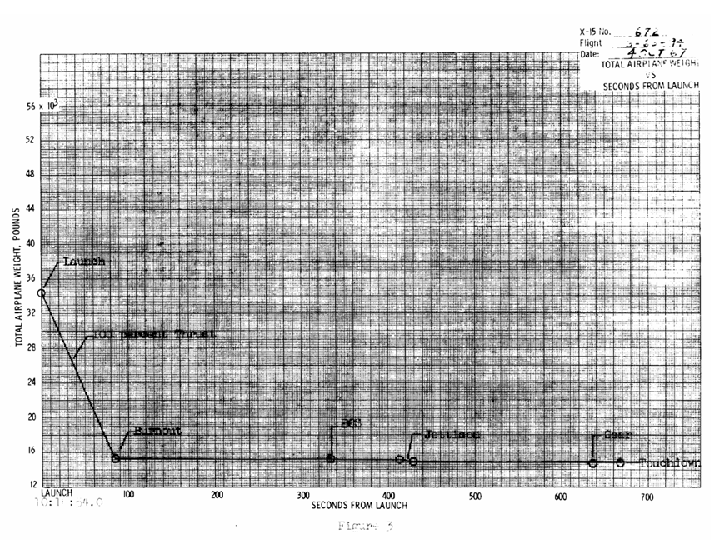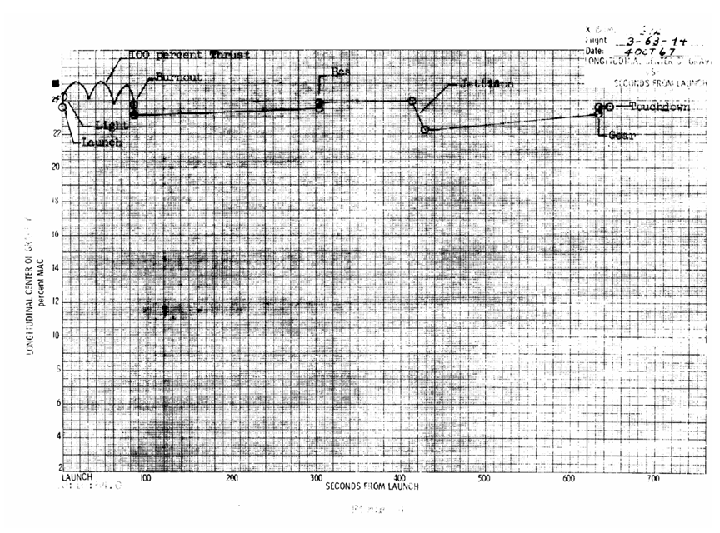
MEMORANDUM for Assistant Chief, Research Projects
Flight 3-63-94 was flown on October 4, l967, by William H. Dana for the purpose of obtaining data for:
b. Solar Spectrum Measurement (29).
c. Micrometeorite Collection (13).
d. Ames Boost Guidance (14).
e. Pod Deflection Scanner (42a).
Acceptable data were obtained on all experiments except the Solar Spectrum Measurement and Pod Deflection Scanner experiments. Solar Spectrum Measurement data were not obtained because the recording channel became inoperative approximately 20 seconds prior to activation of the experiment. Loss of data for the Pod Deflection Scanner was caused by a coating of hydraulic fluid getting on the scanner lens.
There were no major malfunctions during this flight.
Flight Track and Profile
The radar track and profile for this flight are shown in figure 1. The ground track showed launch approximately 1.5 nautical miles east of the planned launch point. Due to a 3.5° discrepancy shown between the actual and the planned ground track, this distance had increased to about 9 nautical miles at China Lake where a right turn was initiated to Edwards. The pilot's display indicated the planned heading was being flown throughout the flight. An analysis of the flight data is proceeding to determine where the discrepancy exists.
The flight profile, as shown in figure 1, was essentially on the planned profile.
Stability and Control
A time history of the significant stability and control parameters telemetered during the flight is shown in figure 2. The launch was from Smith Ranch at an indicated airspeed of 225 knots, Mach number of 0.83, and an altitude of 44,900 feet on a heading of 168 degrees. Launch was normal with the MH-96 system roll-hold engaged. Because of the launch transients the roll-hold mode disengaged as had been expected.
Engine burnout occurred after 84.2 seconds of powered time, at 5600 fps, with the thrust trail-off increasing the velocity to the planned 5700 fps. An apparent thrust misalignment induced 3° of left sideslip at burnout. During the ballistic portion of the flight to peak altitude seven roll maneuvers were performed to obtain data for the ultraviolet exhaust plume measurement experiment. Other experiments were activated as the required altitude was attained.
During the descent from peak altitude the pilot needed the center stick to help hold 20° angle of attack while setting up for reentry.
The reentry was performed at 4.5g and 17° angle of attack. Due to being 0.5g lower than the planned 5g the entry was completed 2000 feet low, thus the pilot elected to balloon to approximately 83,000 feet. During the glide back to Edwards, at 2.8 Mach number and 68,000 feet altitude, a pullup maneuver to investigate buffet experienced on previous flights was performed. No buffet was experienced and the angle of sideslip was less than previous values experienced. The conditions for this maneuver were:
Time b a g
0.0 0 -0.5 -
3.0 sec -1.0 12.0 »3.8
6.7 sec 0 2.5 -
The approach, landing, and rollout were normal.
A time history of the airplane weight is shown in figure 3, and of the longitudinal center-of-gravity position is shown in figure 4. The calculated landing weight was 14,960 pounds with a longitudinal center-of-gravity position of 23.3 percent of the mean aerodynamic chord.
Ultraviolet Exhaust Plume Characteristics
To obtain high-angular resolution data in the solar blind and near ultraviolet region an experiment consisting of a dual channel radiometer and a camera mounted in the tail cone box was flown on this flight. The radiometer, which is the prime component of the experiment, functioned properly; however, the camera did not operate. Postflight examination revealed that the camera film had stuck together and broke when the camera started. Excess moisture condensation within the camera is believed to have caused this problem.
A detailed analysis of the dual channel radiometer data is in progress by the experimenter.
Solar Spectrum Measurement
An experiment designated to obtain solar spectrum data for: improving methods of correcting for atmospheric absorption, calibrating solar cells for validation of a solar simulator, and determining the absolute energy of the sun, was flown in the rear left-hand wing tip pod. No data were obtained on this experiment because the prime recording channel became inoperative approximately 20 seconds prior to activation of the experiment. The experiment and data recording system were checked and run after flight. No apparent problem could be found. However, during preparation for the next flight 10 channels of the prime commutator malfunctioned. One of these channels was the data channel for this experiment. The problem was found to be a bad driver card. The card was replaced. To preclude the loss of data on the forthcoming flight, should the bad driver card not correct the problem, the experiment signal will be recorded on dual data channels.
Micrometeorite Collection
This experiment was activated during the flight by the pilot, at an altitude of approximately 180,000 feet. The experiment extended from the left-hand wing pod nose cone and proceeded through its automatic timing cycle as planned. The experiment functioned normally while exposing four of the collector surfaces 16 seconds each. The collector did not cycle the remaining two faces and when the experiment was retracted by the pilot as the airplane descended through 180,000 feet the collector box door did not close. This door caught the nose cone cap as it closed and held it partially open.
The pod has been removed and sent to the contractor for repair and investigation into the cause of the malfunction. Because of this malfunction the collector package will be retracted at approximately 200,000 feet altitude on future flights. The collector package and flight data have been returned to the experimenter for a detailed analysis.
Ames Boost Guidance
The Ames Research Center's Boost Guidance experiment was programmed in the ALERT computer for this flight. The pilot was to fly the boost portion of this flight using boost guidance as long as the display of pitch attitude was within +5° of the planned 34°. The experiment functioned as expected until, between 80,000 and 100,000 feet the display vernier experienced a transient and the pilot elected to fly the remainder of the powered portion by the theta vernier.
The flight data have been sent to the Ames Research Center for a detailed analysis.
Pod Deflection Scanner
This experiment consists of a camera mounted in the lower bugeye position for photographing the right-hand wing tip pod to determine the pod deflection under thermal and aerodynamic conditions. No data were obtained on this experiment due to a coating of hydraulic fluid on the lens. This hydraulic fluid was blown back from the reservoir drain forward of the camera position. To alleviate this problem the reservoir will be serviced to a 1/2-inch lower level for the next flight.
Data Systems Discrepancies
The following discrepancies were noted on the PCM prime commutator:
Ch. 30 JPL commutator - became inoperative approximately 20 seconds prior to opening experiment door.
Ch. 35 Nose gear S/G 408 - inoperative during flight.
Ch. 27 Sample switch - inoperative during flight.
Ch. 1-35 Rudder pedal position was inoperative during flight.
Ch. 2-67 The Lox bearing temperature was erratic for this flight.
These problem areas are being investigated to determine their causes and the steps necessary to correct them.
Operational Discrepancies
During the landing
pattern the pilot's breathing oxygen low indication light started blinking.
To insure he had a good oxygen supply the remainder of the flight the pilot
initiated his auxiliary system.
E. J. Adkins, Chief
X-15 Research Project
Office



